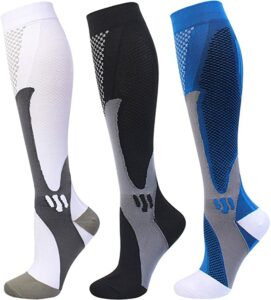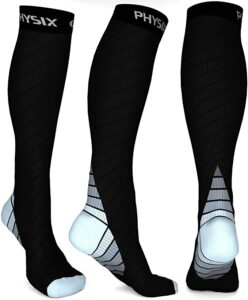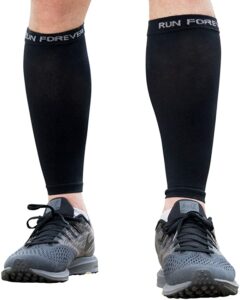Best Compression Socks
Best for Running and Muscle Recovery

Best for Swelling and Travel

Best for DVT and Blood Clot Prevention

Best for Lymphedema and Varicose Veins

What are compression socks?
Compression socks are one of those things that few people wear but many wonder about. In fact, people do not use compression socks enough. They have huge health benefits for both those who deal with medical ailments and for healthy individuals. Frequent travelers, athletes, and office workers can all benefit from a pair of compression socks.
Compression socks squeeze different areas of your legs tighter than a normal pair of socks. Above all else, compression socks enhance circulation in the legs. Compression socks are ideal for athletes, people who stand all day, pregnant women, and bed-ridden individuals.
The benefits of compression socks
Easing venous problems
Leg problems usually begin with the veins. With problems like venous insufficiency, for example, valves of the veins do not function properly. This ultimately blocks ample blood supply to the heart. Compression socks squeeze the skin. This means they effectively reduce fluid loss from the capillaries and stimulate proper blood flow to the heart and other organs.
Reducing inflammation
Due to the ability of compression socks to squeeze the legs, they reduce pressure in the tissues. Compression socks reduce swelling. They are particularly beneficial for those with arthritis or poor mobility.
Preventing DVT and blood clots
When blood pools heavily in the vein it can be extremely dangerous. It can cause the development of varicose veins and in extreme cases, clots otherwise known as deep vein thrombosis. Compression socks reduce the risks of blood pooling.
Aiding in blood flow
You’ve probably noticed changes in your body after sitting for hours on a long-haul flight. Discomfort and swelling happens naturally in the body when going long stretches of time without movement. Compression socks help stimulate circulation to reduce these symptoms.
Lessening pain
Inflammation and swelling in the legs or general body causes pain. By wearing compression socks, you can effectively lessen pain and discomfort.
What makes a great pair of compression socks?
On the whole, there are two types of compression socks. Graduated compression socks are the more basic kind and they are available in a range of lengths and styles. Anti-embolism socks, however, are slightly more complex. People who are bed-ridden or do suffer from health problems will typically be the ones to use the latter. These socks often require a prescription.
Materials
Compression socks usually come in common materials like nylon and polyester. Natural fiber is also a viable material for compression socks. Opt for socks of an opaque as opposed to a sheer fabric for durability.
Calf Support and length
There are compression socks that come both above and below the knee. For those with DVT, stocks typically go below the knee. The most important thing to look for when choosing compression socks is comfort and support around problem areas. Some socks cover the toes and ankles while others do not.
Correct compression
Compression socks apply different levels of pressure to the leg. If you’re using compression socks because you stand or sit all day at work, a milder compression is suitable. Travelers benefit from a medium compression, especially when embarking on long flights. Firm compression is for those prone to blood clots and post-thrombotic syndrome.
How to wear compression socks
Put on the socks and pull them all the way up the legs. Smooth out the socks so they are flat against the skin at all areas of the leg. When compression socks bunch, they aren’t as supportive or effective.
You may want to find a specific pair of shoes that makes the experience of wearing compression socks most comfortable. You can absolutely wear running shoes, slippers, and even sandals with your compression socks. We recommend a shoe that allows for room to wiggle your foot around. Your compression socks should not bunch up in the shoe either.
Best for Running and Muscle Recovery

These compression socks promote circulation and muscle recovery, making them great for athletes. Ideal for long distance runners and cyclists, the compression socks will benefit you over the entire duration of your workout. They prevent cramping and build-up of lactic acid and allow for a complete range of motion.
Breathability is key
The breathable material of these socks keep your feet and legs cool while you exercise.
Best for Swelling and Travel

Due to the range of sizes, these compression socks work for just about anyone. The graduated compression of the socks allows for a boost to blood circulation. They are sturdy yet soft.
Comfort for the long-haul
Due to the impressive 40%-85% nylon makeup of these compression socks, they’re extremely well-fitting. That’s why they’re great for pilots, nurses, or travelers who spend long days on their feet or in transit. Due to their comfort, these are the best compression socks for sitting all day.
Best for DVT and Blood Clot Prevention

The double-stitched seams in these socks make them extra tight and durable. The arch to calf technology initiates immediate shock absorption for DVT prevention. This means that in only moments, the socks reduce pain in the leg. They are a great choice for those who are more prone to blood clots and other inflammatory difficulties. Even withstanding their tightness, people say they can hardly tell they’re wearing them due to their lightweight material.
Rinse and repeat
While a pack only comes with one pair, they wash well and without losing their compression. The Lycra fabric of the socks enhances durability.
Best for Lymphedema and Varicose Veins

If you’re a sufferer of lymphedema and varicose veins, this is the ideal choice for targeted pain relief. Athletes who suffer from shin splints also benefit from the pain relieving benefits of this compression sleeve. Reviewers with chronic pain say this sleeve has significantly relieved symptoms in their legs.
The best of sleeve technology
If you prefer not to have socks squeezing your feet and toes, this sleeve is your best bet. If the problem areas are not around your ankles and feet, sleeves do the trick. It covers your leg from your ankle up your calf. While you wear the compression sleeve, it never slides or bunches.
FAQs about Compression Socks
How do I know if I need compression socks?
If you’re an avid exerciser and suffer from muscle fatigue or shin splints, compression socks are worth considering. If you experience regular inflammation or have a history of blood clotting, your doctor may suggest compression socks.
Should I always wear compression socks when flying?
Once you’ve experienced traveling in compression socks, you probably won’t want to do it any other way. Those prone to DVT are at more risk when flying, so compression socks are particularly important for certain individuals.
Should athletes wear compression socks?
If you’re an avid athlete, you may really benefit from wearing compression socks. Many long distance runners say compression socks greatly help oxygen to circulate around the body.
What if I notice indentations after wearing compression socks?
This is completely normal. Pressure from the elastic in socks can leave marks on your skin. Sometimes, however, too many indentations can be a sign that the compression socks are not the correct size for your feet and calves. It’s important that your compression socks fit you for maximum benefits. When compression socks aren’t the correct size, they can work adversely and cut off your circulation more than they promote it.
Are there any risks involved in wearing compression socks?
On the whole, compression socks do not have risks unless they are not the right fit. Only people with advanced heart issues should be wary and consult their doctor before investing in a pair of compression socks. Compression socks aren’t the only trick to fight things like inflammation. In addition to compression socks when you need them most, you should always drink plenty of water and eat a nutrient rich diet.

